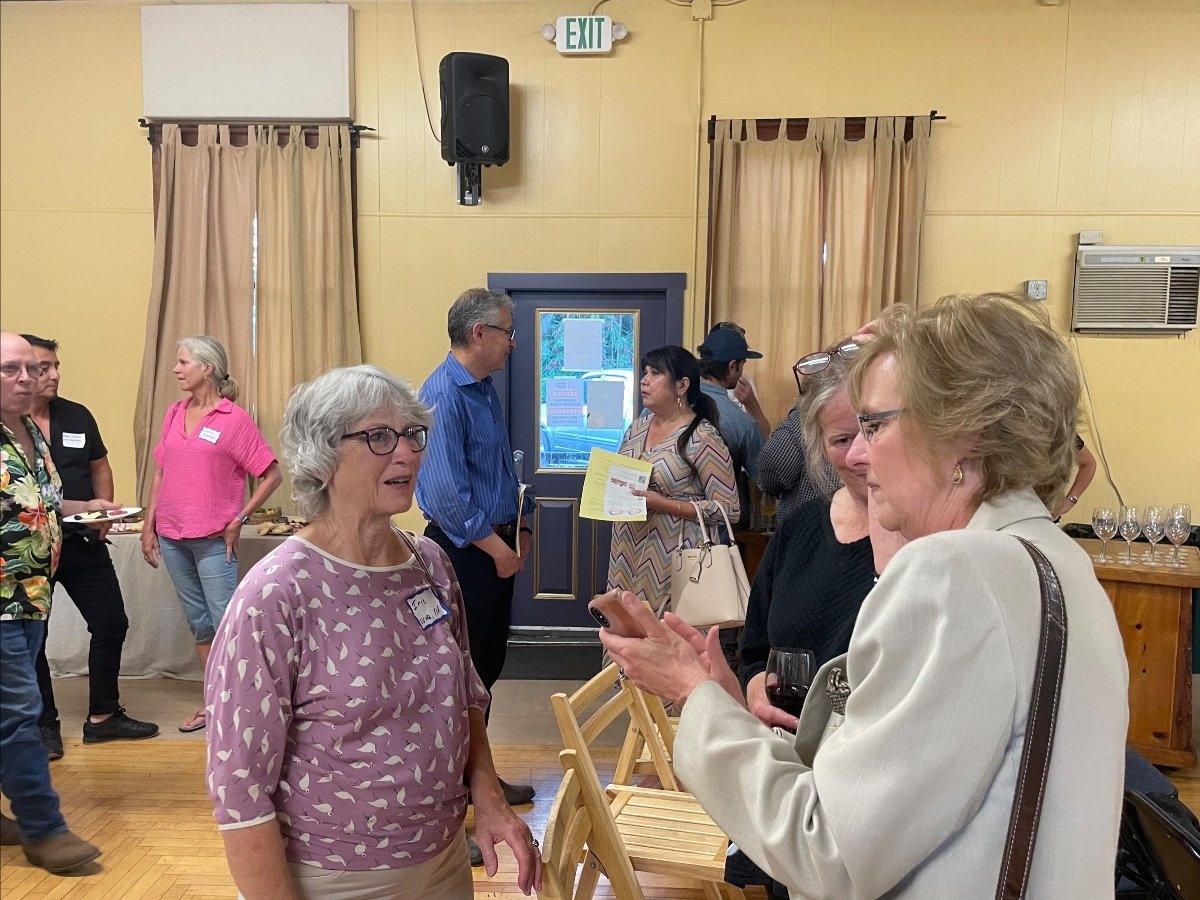Highlights from The State of Housing in Sonoma Valley
Thank you to everyone who took part in The State of Housing in Sonoma Valley, hosted by Sonoma Valley Collaborative and Sonoma Valley Housing Group!
We were delighted to have a full house, with an audience that included many residents, and members of the Springs MAC and Sonoma Valley Catalyst Fund.
Below are highlights from the speakers and audience...
“Bottom line: Sonoma Valley’s salt-of-the-earth community — the common folks, el pueblo, the working class, Latino and Anglo alike — is mostly unrepresented and unheard. We have taken every opportunity to give it a voice and to bring that voice to the table.
In the county, we support the maximum possible affordable housing in the Hanna and SDC projects. In the Sonoma Valley Unified School District, we support the same, including at the school sites that are soon to be vacated. We want to defend our mobile-home parks, limit vacation rentals, tax empty homes, and assure that existing apartments do not go to market-rate status. We’re looking for the city and county to protect renters by adopting rent-control and just-cause eviction, and providing low-income renters with eviction defense. We’re supporting unionizing by the Fairmont workers and getting crisis pay for farmworkers during fires. Low wages are part of the problem. We’re looking to democratize the Valley by annexing the Springs and moving to district elections. And we’re looking forward to working with all of you on these issues.”
“Sonoma: You have a very big decision to make. You need to decide if you want to be a town without children, because that is what is happening. You will be a town without children if we don’t do something quickly.
I am working with a family who is houseless. There were not resources, there were no wrap-around case management services for them. They hit wall after wall after wall. It took an entire team of us to obtain four walls and a roof and the services they need to survive.
When I tell you that there are children sleeping in vans and on floors, it is no exaggeration. That is not how children show up best to learn. But that is their parents doing the very best they can, as they work as our caregivers, housekeepers, landscapers, and in our hotels, working incredibly hard and being incredible parents. I think we spend a lot of time talking about this issue and not thinking about the fact that while we are talking about it there are people who are living it, and those people include children. This has to stop.”
“Housing insecurity aligns with health outcomes. If you don’t know where you are going to live next week or next month, managing your health takes a back seat.
I’ve got 100 examples, I am going to give you one: Martha is middle-aged, insulin-dependent, and currently living out of her car. She comes into the ER with high blood sugar and wounds on her feet. She’s got a cooler in her trunk for her insulin. She is rationing the insulin because she doesn’t have enough. The stress is causing insulin resistance. Her feet are swelling because she is sleeping in her front seat. She walks on those feet, with ulcers, to the store to get ice because she doesn’t want to lose her parking spot. The future of somebody like that is bone infection, sepsis, and amputation. This is a daily occurrence in the hospital’s ER. This is the impact of not having a place to lay your head at night. A place to lay her head would resolve most of that.”
“Many people in [mobile home] parks consider their home their last line of defense against homelessness. They have contributed much to their communities over their lifetimes and are now in danger of having the rug pulled out from under them. We ask you to inform your neighbors, follow the progress of this campaign in the Press Democrat, and be prepared in October to write emails to the Board of Supervisors in support of these changes.”
“Given the high cost of living in Sonoma County, it is generally accepted that an annual income under 200% of the federal poverty level...is inadequate to meet basic needs. Many of our clients are one emergency, one accident, away from being unable to meet their basic needs.
The number one need of our clients is support in housing and shelter. Imagine the stress, the angst, and the worry for individual parents and their children of not having enough income to pay their rent and being at risk of being evicted from their homes. Imagine the stress, angst, and worry of people living in not-very-good housing conditions and being scared to demand that those living conditions be improved out of fear of being evicted. Imagine the stress, the angst, the worry of not being able to find a home because of the high rents.
The need for affordable housing for our clients at La Luz is real, it is urgent, it is now. What we need in Sonoma is affordable homes in all types of neighborhoods.”
“When there’s not enough housing in a place like Sonoma Valley where so many people want to be and there are so many jobs that help people visit and enjoy being here or live great lives here, all the people that serve those wonderful experiences have to drive from somewhere else. So it’s a climate problem.
More than half the people in my own organization have to commute from outside Sonoma Valley. At the hospital, it’s even more. For many people in the school district, it’s the same thing, for our firefighters, police. Imagine when there is an emergency and no one can get here to take care of the town, because they don’t live here. We can do better than that in Sonoma Valley, and we don’t have to do it in a way that destroys our environment. That’s the beauty of having a conversation like this, and bringing [Sonoma Valley] Collaborative together, because we are all these viewpoints together and trying to find the multiple-benefit solutions. That’s all I want to say as an environmentalist: we have to work together.”
“We’re seeing a cycle where families can’t afford housing, and then schools close. It makes me so sad, and I know it does for you too.
We have some great affordable housing projects in Sonoma Valley, like Verano Family Housing near Maxwell Park, that are just sitting, waiting for public funding. It’s not for lack of political will.
The two largest development projects proposed in Sonoma Valley are the Hanna Center and SDC. The new proposal for SDC has only 13% of its housing units affordable! The only thing we agree on is the need for affordable housing, and yet we see these mostly market-rate projects. I don’t know yet what kind of discretion Sonoma County will have in evaluating those.
Please pay attention when plans and projects come up. The only thing I can predict is that these plans will move forward fast. We need your proactive community outreach.”
“When we look at housing, it takes everybody: it takes politicians, developers, financiers, landowners, people to say yes, otherwise it isn’t going to happen. We, fortunately, had a Council at the City of Sonoma that said “Yes, we want housing, we want Affordable Housing”. We have a Housing Element that passed. It warmed my heart that you showed up and delved into policy. That’s how to do it. Please keep doing that. It’s how things change.”
“We have a problem: in order to pass a housing bond in a City or County, you need a vote of two-thirds. As a result, you never hear about housing bonds, because they can’t pass. It is the tyranny of the minority that has kept us from providing this necessary infrastructure. This initiative I am working on will lower the voting threshold needed to pass housing bonds to 55%. It is called ACA1. And it will be followed by a bay-area-wide funding measure for housing, in November 2024, that we all need to get behind.
I want to thank all the people who showed up during [the City of Sonoma] Housing Element to allow us—not to convince us, because we were with you—to allow us to take those hard votes knowing there is a community out there that has our back.”
“A lot of people who don’t have housing are very capable of building houses—they are the people who build houses, they clean the houses, they take care of the land. What they need is the land. All of the intermediary people, and a lot of people in this room, if we are honest, live in houses and probably are in the middle class. And if we are not engaging with people who are actually experiencing this, if we are spending another $10M on another major survey or plan or campaign, then I am really concerned that we are not addressing some immediate needs, for example of single women with children who cannot get into the 55+ [communities] when those are the only spots available. We need something, and to collectivize land is a solution. I’d love to hear a plan for collectivizing ownership for people who are working class, earning under $35,000 a year.”
“We’ve heard tonight these painful stories about the harms of our current housing situation in Sonoma Valley. This is what drives Sonoma Valley Collaborative’s work on housing affordability.
We’ve made a real difference. We have a lot to celebrate. And there’s so much more to do. Our cross-sector coalition brings a unique perspective and power to this issue. Now that the Housing Elements are done, we are pivoting to helping those new policies be most effective, and connecting resources with opportunities so that more affordable homes can be preserved, residents protected, and new infill, affordable homes created.”
Thanks to Betzy Chavez for Spanish translation; Sonoma Valley Unified School District for lending translation headsets; Bardos Cider, Bedrock Wine Co. and Hanzell for drink donations; and Sonoma Valley Grange for being a great gathering place.
A recording is available by request from kim@sonomavalleycollaborative.org.




